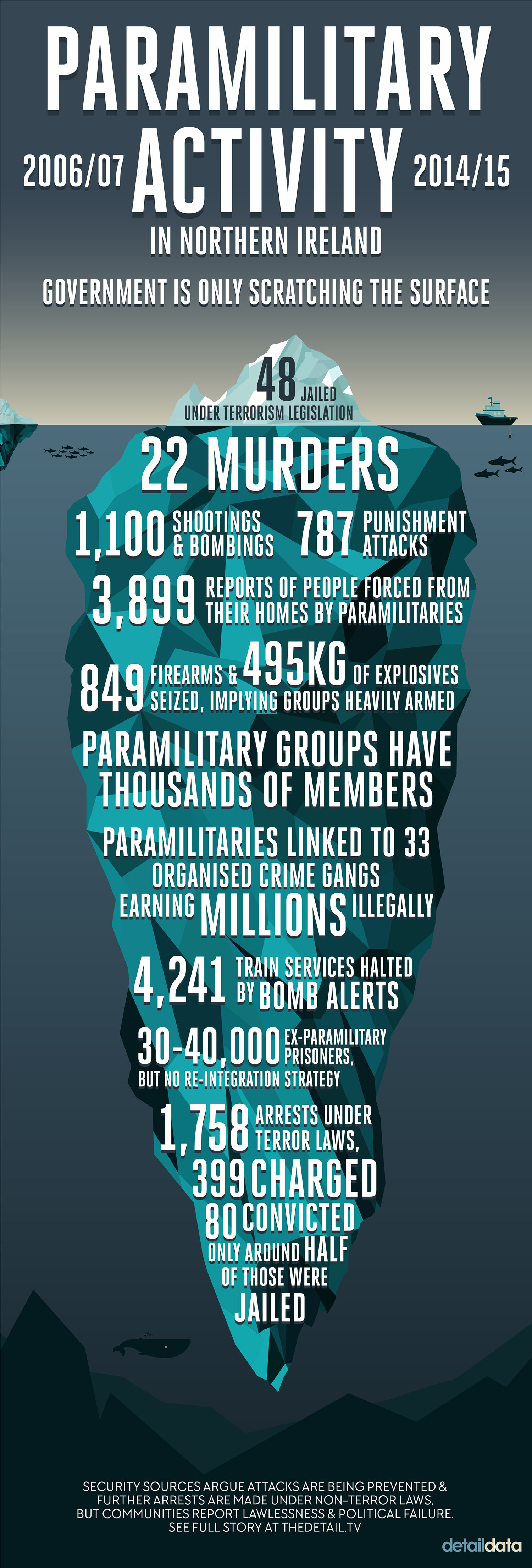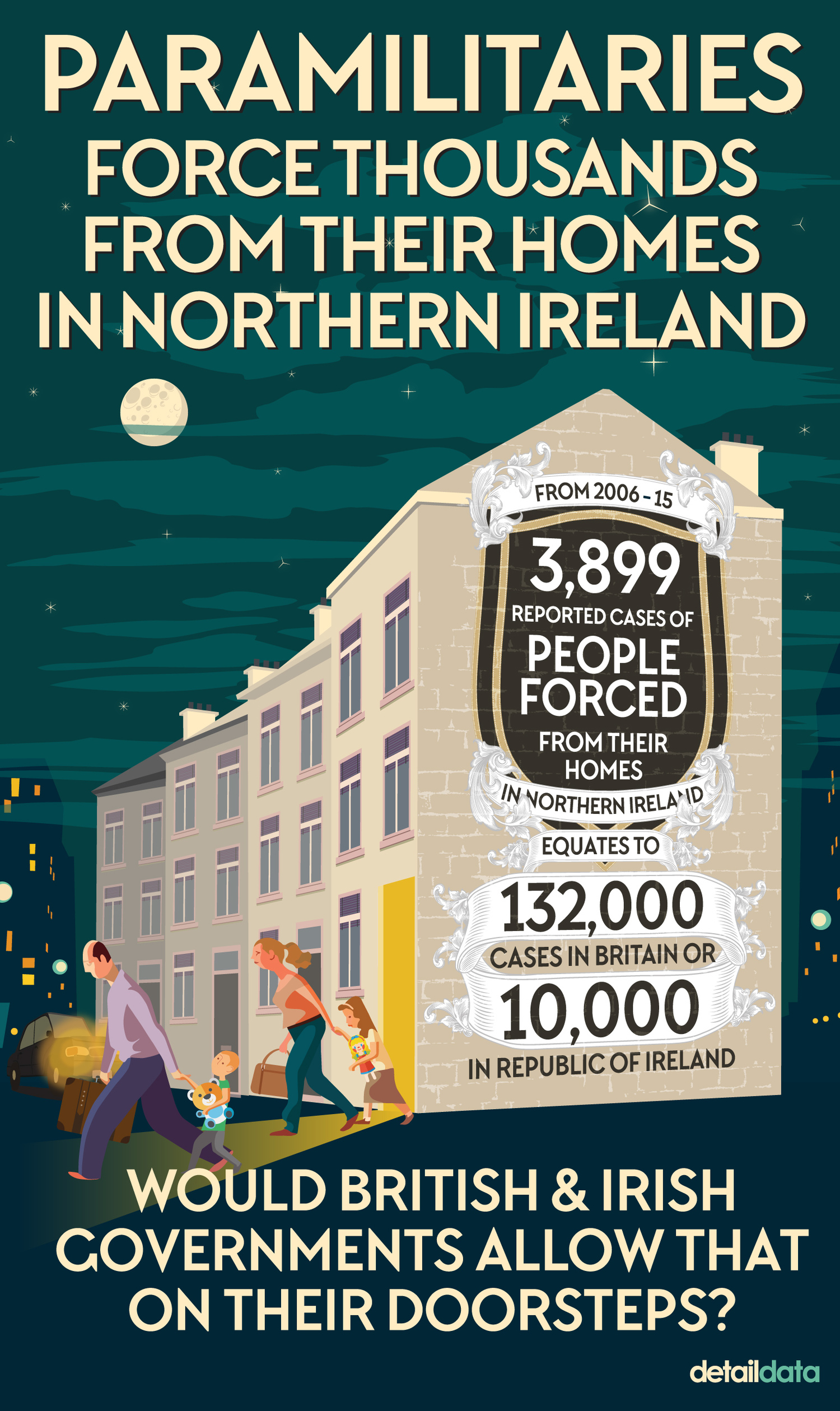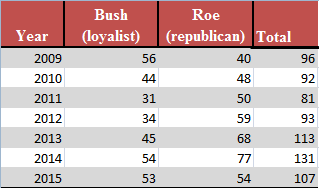PARAMILITARY groups continue to have thousands of members, with organisations involved in hundreds of acts of violence and intimidation each year in Northern Ireland, according to new figures compiled by Detail Data.
From 2006-15 paramilitaries were responsible for 22 killings, more than 1,000 shootings and bombings, 787 punishment attacks, there were nearly 4,000 reports of people forced from their homes by paramilitaries, while security alerts halted more than 4,000 train services.
Police believe there are currently 33 organised crime gangs directly linked to paramilitary groups, amassing tens of millions of pounds each year.
But despite the scale of activity, the Northern Ireland Courts Service confirmed that from 2007-15 there were just over 80 convictions secured under terrorism legislation, leading to 48 prison terms.
Security services have said convictions are also secured under non-terrorism legislation, while they also regularly disrupt planned attacks.
But today’s report includes criticism of government failure to tackle the scale of violence 20 years into the peace process, with evidence that groups retain huge numbers of members, with large amounts of weaponry still in circulation.
Within weeks of the May 5 Assembly elections a government-appointed panel is scheduled to present recommendations on disbanding paramilitary groups.
This comes as there is also a focus on the failure to provide policies to re-integrate the estimated 30,000-40,000 former paramilitary prisoners in Northern Ireland.
Alan McBride of Belfast’s Wave Trauma Centre, whose wife Sharon was killed in the IRA’s 1993 Shankill bombing, said his support group sees the impact of continuing violence across communities every day.
“At least 50% of our referrals today are in relation to ongoing intimidation,” he said.
“It is stuff that happened last week or the week before. It happened on both the loyalist side with loyalist paramilitaries and it happened on the republican side with dissident republican activity. In terms of this centre we would have on average 30-35 new referrals a month.”
He added: “I think 18 years on from the Good Friday Agreement that is not acceptable.”
Despite the success of the peace process in ending large scale violence, the data on paramilitaries shows the continuing high level of activity.
It is also the case that the figures only represent a snapshot of the problem, as they cannot reflect the pressure at grassroots level where communities report experiences of lawlessness.
Police can point to successes, including how from 2006-15 they seized 849 firearms and 495kgs of explosives.
However this may also indicate that illegal groups remain heavily armed.
Police Federation chairman Mark Lindsay said the full picture is obscured by the way data is recorded.
“That is very much down to government recording methodology which states that a terrorist attack is one that is against a national security target,” he said.
“Our issue is that it doesn’t actually give you a true picture of where we are. I’m sure it would be captured somewhere but we are missing all the paramilitary attacks, all the incidents of terrorism that aren’t necessarily directed against police or military.”
But government and its agencies have declined to release data that would allow full scrutiny of its performance in tackling paramilitaries.
AUTHORITIES FAIL TO QUANTIFY PARAMILITARY MEMBERSHIP
Among the first barriers to evaluating the scale of the problem is confirming the size of the various illegal groups.
A question raised in the House of Lords in recent weeks by Ulster Unionist peer Lord Empey enquiring about the numbers still involved in loyalist and republican paramilitary groups failed to deliver an answer from government.
The Police Service of Northern Ireland (PSNI) also told Detail Data it would not provide estimates.
However, a senior officer subsequently did go public to claim dissident republican groups included “several hundred” people.
When Detail Data resubmitted its request asking for estimates of the size of all paramilitary groups the PSNI declined.
According to Rev Dr Gary Mason of Rethinking Conflict, an organisation that has worked closely with loyalist paramilitaries to deliver peaceful outcomes, loyalist paramilitary groups remain large.
“At the heart of loyalist groups there would be a leadership of 30 to 40 people then a membership of several thousand,” he said.
Attendance at paramilitary-linked parades and the funerals of individuals linked to paramilitary groupings can also give an indication of group size and support.
However, writer and political activist Eamonn McCann believes that in many ways, groups view support as being more important than numbers.
“Like many people I was surprised when the IRSP/INLA managed to assemble 150 people in uniform to march at Peggy O’Hara’s funeral,” he said.
“A lot of them, looking at their girths and whiskers were not young recruits.”
On the wider backing for paramilitary groups, he added: “Anyone who doubts that there is significant support for dissident republicans, particularly among young people, shouldn’t.
“As far as I know, to the best of my knowledge, paramilitary organisations are not in a recruitment campaign as at the moment they don’t need an awful lot of numbers.”
In 2007 MI5 took over lead role for national security intelligence work in Northern Ireland, with director general Andrew Parker stating in 2013 that the move had enabled the “vast majority” of dissident republican attacks to be “detected and disrupted”.
Despite this, MI5 states that the threat continues to be severe in Northern Ireland and moderate in Britain.
INSIDE PRISONS
Data provided by the Northern Ireland Prison Service shows the number of individuals held in separated wings housing loyalists and republicans between 2009 and 2015 at Maghaberry Prison in Co Antrim.
The figures, shown in the table below, reveal the number of loyalist prisoners housed each year in the jail’s Bush House and the number of republicans held each year in its Roe House facility.
It is not possible to ascertain from the data the duration of a prisoner’s term or whether prisoners have served more than one term during the seven year period. As such a total number of individual prisoners is not available.
Prison authorities in the Republic said there are on average 40 republican prisoners held in Portlaoise prison at any one time.
TRAVEL DISRUPTION
While some communities suffer higher levels of paramilitary activity than others, figures obtained by Detail Data also illustrate the scale of disruption across Northern Ireland.
Data secured through Freedom of Information requests made to Translink and PSNI showed how security alerts and paramilitary attacks had forced road closures and stopped rail travel.
From 2013-15 there were 193 road closures, while between 2006-15 there were 176 security alerts on rail lines, halting more than 4,000 train services.
Between 2013-15 there was just one month (June 2015) in which a road or rail line was not closed due to a security alert.
To view the interactive version of this chart showing daily disruption, click here:
A FRESH START?
Given the scale of the wider paramilitary problem the Fresh Start Agreement, negotiated last year to stabilise the political process in Northern Ireland, appointed a three person panel to advise on the issue.
The members of the “Panel on Disbanding Paramilitary Groups” are former Alliance Party Leader Lord Alderdice, Women's Coallition founding member Professor Monica McWilliams and the solicitor John McBurney.
The panel is scheduled to report in May, at a time when some experts in the field are arguing for a version of the United Nations endorsed concept of DDR (disarmament, demobilisation and reintegration).
This could see existing barriers to employment, travel and insurance removed for many ex-prisoners, allowing them to re-integrate into society.
Government is criticised for failing to introduce a re-integration strategy for former paramilitary prisoners.
In addition, the Department of Justice said it had no official figures for the numbers of former paramilitary prisoners.
But estimates place the figure for ex-prisoners that were jailed during the Troubles at 30,000-40,000.
However, the Sentence Review Commission confirmed that since 1998, 21 of the prisoners released early were recalled to prison, while 13 ultimately had their early release licence revoked.
According to former republican prisoner Michael Culbert of Coiste na nIarchimí, a group that works with former PIRA prisoners, removing barriers to employment would also eliminate a potential recruitment tool for dissident groups.
“A weapon being used against support for the peace process are people, a lot of them former political prisoners, pointing and saying nothing has changed,” he said.
“There is a sizeable rump, not very big, but if we are truthful about it, it only takes one finger to pull the trigger.”
Former loyalist prisoner Tom Roberts of EPIC, a group working with former prisoners from the loyalist UVF, said a working group from the Office of First Minister and deputy First Minister (OFMDFM) had produced a strategy to reintegrate ex-prisoners.
He said the employment guidelines the working group proposed in 2007 failed as a result of political barriers.
“If you don’t give people who were involved in the conflict the chance to avail of the services that are available to the general public then it makes it more difficult for these groups to civilianise,” he said.
“The ex-prisoners’ working group which has been chaired by the successive heads of the civil service has been in operation since the Good Friday Agreement. And while the civil servants who service that group have been more than helpful in trying to address the issues, without the political will there has really been no movement on those issues.
“No sooner had the guidelines gone into the public domain [in 2007] than there was a question asked in the Assembly and the then Minister for Finance and Personnel said the guidelines that currently existed then were adequate and there would be no change.
“I can understand some of the opinions and some people and parties in Northern Ireland are very retributive in their nature and I can understand that to a certain extent.
“But in terms of being pragmatic about these things, is it wise to have potentially 30,000 people economically inactive and potentially their offspring having difficulties becoming economically active?
“It has been proven internationally that one of the main requirements in a post conflict situation is to have a DDR process. The problem here was politically there was never an acknowledgement that there was a conflict. I would advocate a DDR process, but maybe to make it politically acceptable they would have to use some other terminology to achieve the same thing.”
Detail Data asked Stormont’s Department of Finance and Personnel, which sets civil service recruitment policy, for its current position on the employment of ex-prisoners.
However, the department declined the opportunity to respond.
For Alan McBride the prospect of ex-paramilitaries having such barriers removed would be difficult for many victims to accept, but could be necessary for wider society.
“I know from working at Wave, we have many people here, who have reached that point where they are ready to sit down and meet with people who were involved in atrocities and discuss the future of Northern Ireland. We have others that it would be an anathema to even contemplate sitting down with someone who was involved in terrorism.
“I think that we do have to move on. We do have to find a way of dealing with the hurt and all of the trouble that was caused in the past.”
Click here to view all the data from this project in our data store.
 By
By




